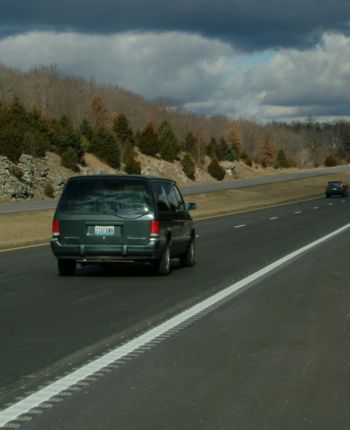626.1 Edgeline Rumble Strips

Edgeline rumble strips are used to enhance safety on every paved shoulder at least 2 ft. wide, unless the shoulder has a curbed section or is intended to be used as a future travel lane. Rumble strips are omitted where the posted speed is less than 50 mph. All major roads will have edgeline rumble strips unless the posted speed is less than 50 mph.
In most situations, edgeline pavement marking material is sprayed over the milled rumble strip, creating what is referred to as a “rumble stripe.” (See Standard Plan 620.00.) Any deviation from this typical application shall be submitted as a design exception.
Where full depth pavement extends beyond the travel lane and into the shoulder area at least 12 inches (e.g., pavement widths 13 ft. or greater), the rumble stripe should be placed in the full depth section of widened pavement (see Standard Plan 626.00).
When resurfacing and milling rumbles, the roadway surface course asphalt mix used for the travel lanes should extend a minimum of 18 inches beyond the edge of the travel lane and onto the shoulder so that the rumble strip is milled into the roadway surface course mix. (See EPG Shoulder Surface for additional monolithic shoulder paving guidance.) Edgeline rumbles should not be milled into existing asphalt shoulder pavement due to oxidization and potential raveling.
Where the width of full depth pavement does not extend at least one (1) foot onto the shoulder, and the rumble strip must be placed on, or partially on, a shoulder with less than full depth pavement, as indicated on Std. Plan 626.00 (≤ 12’ Pavement Structure), the condition and depth of the shoulder structure should be evaluated prior to determining the location of the edgeline. If the shoulder condition and depth is deemed adequate to support routine off-tracking of traffic onto the rumble strip, the edgeline stripe should be placed over the rumble strip as shown in the standard plans (i.e., rumble stripe). If evidence suggests the shoulder condition or depth is inadequate to support routine off-tracking of traffic onto the rumble strip, placement of the edgeline stripe and rumble strip may be considered as follows:
- For major roads, the edgeline stripe should be placed in the travel lane with the rumble strip placed 4 inches beyond the edgeline stripe. The rumble strip should not be moved further out from the centerline. A design exception shall be submitted when separating the edgeline stripe from the rumble strip. See EPG 231.4 Shoulder Width for recommended shoulder widths.
- For minor roads, a mini rumble strip (6 inches wide) should be placed along the edge of the travel lane structure provided sufficient driving width remains. If sufficient driving width cannot be achieved, rumble strips should not be used. When a centerline rumble is not used, sufficient driving width is defined as having a minimum of 10 ft. between the centerline joint and the inside edge of the edgeline rumble. When a centerline rumble is used, sufficient driving width is defined as having a minimum of 10 ft. between the edge of the centerline rumble and the inside edge of the edgeline rumble. The edgeline stripe (4 inches) should be placed over the inside edge of the mini rumble strip (i.e., mini rumble stripe).
- District Responsibility. Collaboration with the Central Office Highway Safety and Traffic Division and the Design Division is necessary prior to approval of a design exception to omit or modify these system-wide safety improvements (such as rumble strips) on a project. Design exceptions should include documentation of the crash history and safety analysis of the route, or segment of the route, where the design exception is being applied.
In urban areas, where the rumble noise has been identified as a significant issue, the preferred method of mitigation is to place the edgeline stripe on the edge of the travel lane and the rumble strip 1 ft. onto the shoulder pavement. In areas where this is insufficient to mitigate noise concerns, rumble strips may be omitted for short sections, by design exception only.
| Safety Results 2-ft. Shoulder with Rumble Strips |
| Summary for 2ft Shoulder with Rumble.pdf Summary, 2015 |
| Tech Memo, 2015 |
| See also: Research Publications |
Edgeline rumble strips are to be milled into bituminous and portland cement concrete. Edgeline rumble strips are omitted through side road approaches, entrances, and median crossovers as shown in Standard Plan 626.00. Edgeline rumble strips should be omitted on bridges and on ramps for diamond, single point, partial cloverleaf, and similar types of interchanges, but may be considered on longer ramps for directional or other large interchanges. The length of edgeline rumble strip installation is to be estimated and pay items provided.